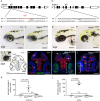Epigenetic regulators Rbbp4 and Hdac1 are overexpressed in a zebrafish model of RB1 embryonal brain tumor, and are required for neural progenitor survival and proliferation
- PMID: 29914980
- PMCID: PMC6031359
- DOI: 10.1242/dmm.034124
Epigenetic regulators Rbbp4 and Hdac1 are overexpressed in a zebrafish model of RB1 embryonal brain tumor, and are required for neural progenitor survival and proliferation
Abstract
In this study, we used comparative genomics and developmental genetics to identify epigenetic regulators driving oncogenesis in a zebrafish retinoblastoma 1 (rb1) somatic-targeting model of RB1 mutant embryonal brain tumors. Zebrafish rb1 brain tumors caused by TALEN or CRISPR targeting are histologically similar to human central nervous system primitive neuroectodermal tumors (CNS-PNETs). Like the human oligoneural OLIG2+/SOX10+ CNS-PNET subtype, zebrafish rb1 tumors show elevated expression of neural progenitor transcription factors olig2, sox10, sox8b and the receptor tyrosine kinase erbb3a oncogene. Comparison of rb1 tumor and rb1/rb1 germline mutant larval transcriptomes shows that the altered oligoneural precursor signature is specific to tumor tissue. More than 170 chromatin regulators were differentially expressed in rb1 tumors, including overexpression of chromatin remodeler components histone deacetylase 1 (hdac1) and retinoblastoma binding protein 4 (rbbp4). Germline mutant analysis confirms that zebrafish rb1, rbbp4 and hdac1 are required during brain development. rb1 is necessary for neural precursor cell cycle exit and terminal differentiation, rbbp4 is required for survival of postmitotic precursors, and hdac1 maintains proliferation of the neural stem cell/progenitor pool. We present an in vivo assay using somatic CRISPR targeting plus live imaging of histone-H2A.F/Z-GFP fusion protein in developing larval brain to rapidly test the role of chromatin remodelers in neural stem and progenitor cells. Our somatic assay recapitulates germline mutant phenotypes and reveals a dynamic view of their roles in neural cell populations. Our study provides new insight into the epigenetic processes that might drive pathogenesis in RB1 brain tumors, and identifies Rbbp4 and its associated chromatin remodeling complexes as potential target pathways to induce apoptosis in RB1 mutant brain cancer cells.This article has an associated First Person interview with the first author of the paper.
Keywords: CRISPR somatic targeting; Epigenetic regulators; Hdac1; Neural progenitor; RB1 embryonal oligoneural brain tumor; Rbbp4; Zebrafish.
© 2018. Published by The Company of Biologists Ltd.
Conflict of interest statement
Competing interestsThe authors declare no competing or financial interests.
Figures







Similar articles
-
Rbbp4 loss disrupts neural progenitor cell cycle regulation independent of Rb and leads to Tp53 acetylation and apoptosis.Dev Dyn. 2022 Aug;251(8):1267-1290. doi: 10.1002/dvdy.467. Epub 2022 Mar 18. Dev Dyn. 2022. PMID: 35266256 Free PMC article.
-
MEK Inhibitors Reverse Growth of Embryonal Brain Tumors Derived from Oligoneural Precursor Cells.Cell Rep. 2016 Oct 25;17(5):1255-1264. doi: 10.1016/j.celrep.2016.09.081. Cell Rep. 2016. PMID: 27783941
-
The epigenetic regulator Histone Deacetylase 1 promotes transcription of a core neurogenic programme in zebrafish embryos.BMC Genomics. 2011 Jan 12;12:24. doi: 10.1186/1471-2164-12-24. BMC Genomics. 2011. PMID: 21226904 Free PMC article.
-
In vivo and in vitro models of medulloblastomas and other primitive neuroectodermal brain tumors of childhood.Mol Chem Neuropathol. 1994 Feb-Apr;21(2-3):219-39. doi: 10.1007/BF02815352. Mol Chem Neuropathol. 1994. PMID: 8086035 Review.
-
Speculations on the roles of RB1 in tissue-specific differentiation, tumor initiation, and tumor progression.FASEB J. 1993 Jul;7(10):846-54. doi: 10.1096/fasebj.7.10.8344484. FASEB J. 1993. PMID: 8344484 Review.
Cited by
-
Psoriatic Dermal-derived Mesenchymal Stem Cells Reduce Keratinocyte Junctions, and Increase Glycolysis.Acta Derm Venereol. 2020 Apr 21;100(8):adv00122. doi: 10.2340/00015555-3480. Acta Derm Venereol. 2020. PMID: 32266413 Free PMC article.
-
Rbbp4 loss disrupts neural progenitor cell cycle regulation independent of Rb and leads to Tp53 acetylation and apoptosis.Dev Dyn. 2022 Aug;251(8):1267-1290. doi: 10.1002/dvdy.467. Epub 2022 Mar 18. Dev Dyn. 2022. PMID: 35266256 Free PMC article.
-
Regulation of Central Nervous System Development by Class I Histone Deacetylases.Dev Neurosci. 2019;41(3-4):149-165. doi: 10.1159/000505535. Epub 2020 Jan 24. Dev Neurosci. 2019. PMID: 31982872 Free PMC article. Review.
-
Pediatric Cancer Models in Zebrafish.Trends Cancer. 2020 May;6(5):407-418. doi: 10.1016/j.trecan.2020.02.006. Epub 2020 Mar 13. Trends Cancer. 2020. PMID: 32348736 Free PMC article. Review.
-
Modeling Neuronal Diseases in Zebrafish in the Era of CRISPR.Curr Neuropharmacol. 2020;18(2):136-152. doi: 10.2174/1570159X17666191001145550. Curr Neuropharmacol. 2020. PMID: 31573887 Free PMC article. Review.
References
-
- Aldiri I., Xu B., Wang L., Chen X., Hiler D., Griffiths L., Valentine M., Shirinifard A., Thiagarajan S., Sablauer A. et al. (2017). The dynamic epigenetic landscape of the retina during development, reprogramming, and tumorigenesis. Neuron 94, 550-568.e510. 10.1016/j.neuron.2017.04.022 - DOI - PMC - PubMed
-
- Alqarni S. S. M., Murthy A., Zhang W., Przewloka M. R., Silva A. P. G., Watson A. A., Lejon S., Pei X. Y., Smits A. H., Kloet S. L. et al. (2014). Insight into the architecture of the NuRD complex: structure of the RbAp48-MTA1 subcomplex. J. Biol. Chem. 289, 21844-21855. 10.1074/jbc.M114.558940 - DOI - PMC - PubMed
-
- Balciunas D., Wangensteen K. J., Wilber A., Bell J., Geurts A., Sivasubbu S., Wang X., Hackett P. B., Largaespada D. A., McIvor R. S. et al. (2006). Harnessing a high cargo-capacity transposon for genetic applications in vertebrates. PLoS Genet. 2, e169 10.1371/journal.pgen.0020169 - DOI - PMC - PubMed
Publication types
MeSH terms
Substances
Grants and funding
LinkOut - more resources
Full Text Sources
Other Literature Sources
Medical
Molecular Biology Databases
Research Materials
Miscellaneous

